Вы здесь
Chapels in town Vernyi.
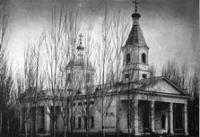
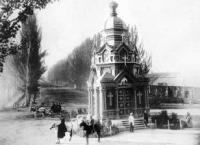
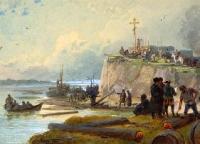
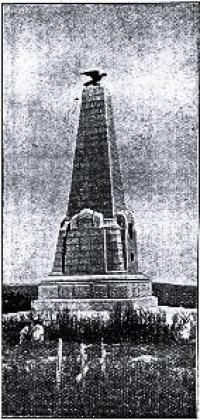
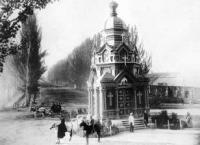
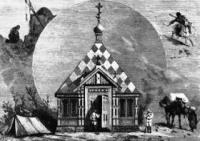
Weekend tours in Almaty.
“Since the gods know everything, he who appears in the temple should honestly offer one single prayer:“ Gods, give me what I deserve ”
Flavius Philostratus (senior).
Trip from Almaty to Kapshagai.
Chapel, temple - a monument above the throne of the former church, also, at the crossroads of roads, at places of interest, in the cemetery, in memory of formidable natural phenomena, historical events. This is a prayer room without an altar, where the hours are served, not the liturgy.
Usually, there was a icon case, filled with icons, and in front of it a lit lamp - a holy torch of Orthodoxy on the far outskirts of Asian Russia. Temples and chapels, charitable institutions were the only monumental buildings of the villages of the Semirechensky Cossack army, their true decoration and pride, a place of attraction for the entire public life of the stanitsa.
Religious and government buildings were built according to standard designs, with preference in the volume-planning solution of cubic volume. Buildings built in this style have not been preserved. Soviet art criticism wrote: "the neo-Russian style prevailed in the construction of churches, the eclectic mix of architectural forms and decor elements of ancient Russian architecture."
The word "eclecticism" in the world of Soviet art was abusive. A one-sided assessment of the heritage of the period of the “Russian” style served as a moral justification for the destruction of monuments of church architecture.
Only in preparation for the publication of the Code of Historical and Cultural Monuments of the Semirechye, a new unexplored layer of the architectural heritage of Russian church architecture was discovered. The first monument in memory of the passage of the expedition of MD Peremyshlsky through Ili in the summer of 1853 was a chapel "on the porphyry rocks of Kapchagay."
The very name of the Ili River was taken by immigrants as the locality of the Prophet Elijah, and therefore they put the first Iliysky church in his name. Mastering the foothills of the Trans-Ili Alatau, the first settlers called them the Olives, according to the same biblical Christian tradition.
The settlers erected in 1871 the Kazan Church-monument in the Lesser Town, the foundations of the Almaty villages and the victory in the Uzun-Agach case (1860), the expulsion of Kokants from the Semirechensk Territory.
In addition, a “Kaufman's gazebo” was established in Tastak, a meeting place and farewell for distinguished guests of the region, whose hands were planted Tastak, the so-called "crying" grove. Among the first monuments, we note the chapels put in memory of the victims of the Vernyi earthquake of 1887 and 1910, tombstones on the graves of the first settlers and military personnel who died heroically during the years of development of the region.
It should be noted that the forms of perpetuation of people's memory were different. First of all, the installation of portraits and busts of philanthropists, land improvements, outstanding doctors, teachers, engineers at their place of service: in hospitals - inscribed beds of surgeons; in libraries - registered collections of books; in museums - personal collections of donors.
In the same way, urban names appear in everyday life - Alferov and Baum groves, Verigin’s mountain and Pugasov bridge, Zubovskaya square or Obukha street. The first monumental monuments of the late nineteenth - early.
XX century there were memorial structures at the battlefield near Uzun-Agach (1905, sculptor A. Gauguin, architect S. Troparevsky), the Turkestan Cathedral (laid for the 50th anniversary of the founding of the city), a monument - a bust to Alexander the Second, “to under whose Semirechye arose as a power ”(grand opening took place on September 17, 1912).
The installation of a monument to G.A. Kolpakovsky (author P. Gourde) was undertaken. But, the funds raised were dissolved in the whirlpool of revolutionary events in Verny. Everything has sunk into oblivion...
Chapels in the town Vernyi.
The chapel at the Holy Spring in the Vernyi fortification was converted on November 14, 1858 to the first village church of the Holy Martyrs of Sofia in Almaty and its daughters Faith, Hope, Love, heavenly patrons of the Church of the Seven Rivers; Civil engineer P.A. Nikitin.
The shrine is preserved in the drawing of the artist M.S. Znamensky, marked with the date "the end of June 1864." The chapel over the Holy See seat of the Turkestestan Cathedral, destroyed by an earthquake on May 28, 1887, was demolished, was located in a city park, now the eastern part of 28 Panfilov guardsmen.
The history of the Cathedral is short and sad. The temple building was erected in 1884 and died three years later in a natural disaster. A local newspaper wrote about this: “... the construction of the Cathedral began in 1868.
Its construction was entrusted to the Committee for the device of the city. A street lined with trees was drawn to this cathedral in 1869 from the Almaty village. In the place designated for the governor’s house, gardening has begun.
A place for a cemetery was selected and surrounded by a moat and rampart and a chapel made of stone was built on it ”(we are talking about the development of the Park by 28 Panfilov guardsmen now. VP) However, the improvement of Cathedral Square gave impetus to the development of the New City south-west of the village.
In 1869 - 1874 the boulevard (from 1879 Sobornaya St., then General Kolpakovsky Avenue, from 1919 Lenin Avenue, now Dostyk) was held. In 1912, the eastern section of the park, popularly called the Church or Gethsemane garden, was landscaped, the ruins of the foundation of the temple were planted with white acacia, eaves and benches were erected, a monument-bust to the emperor Alexander the Liberator was erected.
In 1899, the western part of the city park, previously occupied by the village cemetery, began to be called the Pushkin Garden. Here was laid and in 1907 a new Turkestan Cathedral was erected. We find the description of the chapel in the funeral ceremonies of the first Bolsheviks of Semirechye K. Ovcharov and A. Berezovsky.
In April 1919, the city park received in connection with this event the name "Park of the Fighters for the Fallen for Freedom." The newspaper notes that the organizers, having previously broken through the hole in the foundation of the chapel, placed the coffins of the heroes inside the room, like pots on the grip.
After the mudflow of 1921, the chapel was cleared and organized by the communist pantheon, where the party-Soviet elite of the city was interred. After the war, the Memorial of Glory was smashed at this place, with the lighting of the Eternal Flame.
In the early morning of May 28, 1887 (according to the old style), the largest earthquake in the history of geology occurred in Verny. The area of destruction was enormous: Ayaguz in the north, Kashgar in the south, Tashkent in the west, and Urumqi in the east.
Vernyi tragedy was heard by magnetic instruments of Pavlovsk, Nikolaev, Berlin and several other seismic stations. The epicenter of the earthquake was on the northern slope of the Zailiysky Alatau, in the Big-Almaty gorge.
The chapel in memory of the earthquake of December 28, 1910, stood behind the Small village at the fork of the Talgar and Kuldzhinsky tracts. It was supposed to build four chapels, on all four sides of the world and the entrance to Verny.
They managed to put one before the revolution. Incidentally, the Maloalmatinskaya chapel took its place in the history of ... aviation. It was chosen as a reference point for the airplane arriving in our city on April 1, 1919, the first flight of the military pilot A. Shavrov in the history of the Seven Rivers, with the flight Aktyubinsk - Tashkent - Verny.
A communist subbotnik was organized, they removed the excess, and prepared an aero site. “It was in 1919,” the eyewitness recalled. An airplane suddenly appeared over the city. He flew from west to east, rang and chattered in the sky, and all this seemed like some kind of magical dream.
An amazing car flew to the outskirts of the city, drove down and sat on a flat green meadow. What started here! Both old and young, rushed into the field. ”Ahead of them, raising thick street dust, the boys screamed with screeching and screaming.”
During the organization of the “Ray of the East” collective farm, the chapel was demolished; building materials were supposed to be built either on a school or on a collective farm bookstore. Yes, you see, and did not fit...
Chapel of Bratsk, in memory of the icon of the Kazan Mother of God. Delivered by the Semirechensk Orthodox Brotherhood. December 17, 1895 was converted to the All Sorrowful Church in the Small Bazaar. In Soviet times, the building was used as a club of pioneers named after Inessa Armand, then the music school named after Glier. It was demolished in 1987 during the construction of an office building on Furmanov and Gorky streets.
Chapels of the Seven Rivers.
A chapel commemorating the passage of the first settlers of the river Ili in the summer of 1853. Put at the expense of the merchants Vladimir and Vasily Kuznetsov on the porphyry rocks of Kapchagai; builder Pavel Zenkov. In 1874, she was converted to the village church of the Holy Prophet Elijah.
In the middle of the summer of 1853, the military detachment of the Bailiff of the Great Horde Mikhail Peremyshlsky, leaving Kopal, approached the ancient Oguz-Utkul crossing, which led through the wayward Asian river Ili to the mountains and valleys of the Tien-Shan.
The squad was met by an unprecedented thunderstorm and the crossing into the storm dragged on for almost a week. The extremely difficult circumstances of that memorable year forced the bailiff to settle in Issyk. First of all, internecine strife, which suddenly broke out among the Tien-Shan peoples, and the incredibly cold winter, which caused a feedlessness and a case of horse-drawn transport, prevented the advancement of the detachment.
Only by the spring of next year, having studied the foothills of the Zailiysky Alatau, laying down food and fodder bases, the Peremyshlsky detachment chose the site for the construction of the Vernoye fortress in the tract of Malaya Almatinka.
In 1965 - 1971, a hydroelectric complex was erected in the Kapchagai Gorge (project by architect E.V. Erhart, engineer N.V. Vologdin). The old village of Iliysk (founded in 1853), with it the monuments of its history, construction and landscaping, were in the flood zone and went to the bottom of the man-made Kapchagai reservoir.
A chapel in memory of the Uzun-Agach case in 1860 (v. Kazan. Bogorodskoe; founded in September 1859;; since 1870, a peasant village named in memory of the autumn icon of the Kazan Mother of God, under whose cover, the main historical events of the Seven Rivers took place. Now, Almaty region, Karasai district).
A chapel and a monument were erected on the Saurukov Kurgan over the Mass grave of the killed soldiers; the chapel was destroyed by the earthquake of 1887. In 1905 it was restored in connection with the construction of a new monument of Glory (sculptor A.I. Gauguin architect S. Troparevsky).
Uzun-Agach case, the battle on the territory of Kara-Kastek (October 19 - 21, 1860) against the expansion of Kokand to the lands of the Great Horde of the Seven Rivers. In the case from the Kokand side, a united detachment of Kokand, Andijan, and Dulat participated under the command of the warlord (Seraskir) Kanagat-shah of 16,000 infantry and 5,000 Dulat cavalry, 10 artillery guns.
n the Russian side - the Za-Ili detachment of Lieutenant Colonel Kolpakovsky (9 companies, 6 hundreds with 9 guns and 2 machine gun missiles; 2440 men in battle; in the reserve, for the defense of Verny, a garrison was left (composed of volunteers, mainly women, old men, pa 5 companies, 4 hundreds, 4 guns and 5 rocket machines).
The main battle took place at dawn on October 21, 1860 by Shtykova, and hand-to-hand combat lasted 9 hours. Losses from the enemy amounted to about one and a half thousand dead and wounded, including 6 pensions (five hundred military commanders).
n the Russian side - 1 killed, 26 wounded and 6 shell-shocked, among which officers G. Kolpakovsky and G. Syarkovsky. The first Kazakh, awarded the medal “For Courage”, was Sultan Ables Abliev, of the Ablaykhanov family, a interpreter of the Bailiff of the Big Horde, the hero of the Uzun-Agach case.
The first with the news of victory in Verny returned the detachment of D. A. Shaitanov. The solemn days coincided with the celebration of the autumn icon of the Mother of God of Kazan, therefore, in the village of Small-Almaty, the Kazan Church monument was erected (preserved to this day), on the occasion of the 50th anniversary of the battle, the Army Cathedral in the Great Village was named "Uzun-Agach"; the street and boulevard of the city were named; the village of Uzun-Agach itself was renamed Kazan-Bogorodskoye.
In 1921, during the celebrations of the anniversary of the national uprising of 1916, it was decided to demolish the monument in Uzun-Agach. As a proletarian response to the "note of Lord Curzon" (in those revolutionary years there were similar civil executions - performances).
However, the muscles of the hands and the energy of the oxen managed to rip off the medallions with portraits of the heroes of the Sich, overthrowing, in the form of an eagle, tearing in its claws a map of the possessions of the Kokand khanate.
It was not possible to bring down the monument to the ground. All metal was delivered to the iron foundry, which, as you know, was never put into operation. In 2007, the Semirechye Cossacks restored the monument, but without a chapel above the mass grave (also lost).
The restoration was carried out on its own, without analysis of the original project, with the inclusion in the monument of false elements that had never been on this obelisk of Glory.
Literature:
St. George Knights, issue. 3., St. Petersburg, 1861; Nedzvetsky V.E. Uzun-Agach case (historical reference to the 50th anniversary of October 21, 1860), Verny, 1913
Proskurin V.N. Verny (Alma-Ata, Almaty) in the book: Code of monuments of history and culture of Almaty-Almaty: Kazakh Encyclopedia, 2006 - pp. 37 - 126; his own.
Orthodoxy of the Seven Rivers in the monuments of history and culture of Kazakhstan (XIX-XX centuries).
In the book "On the History of Christianity in Central Asia." Tashkent, 1998, pp. 47 - 61; his own.
The fate of seditious obelisk.
Monuments of history and culture of Kazakhstan, vol. 5, 1992
Authority:
http://proskurin.ucoz.kz/publ/1-1-0-39







